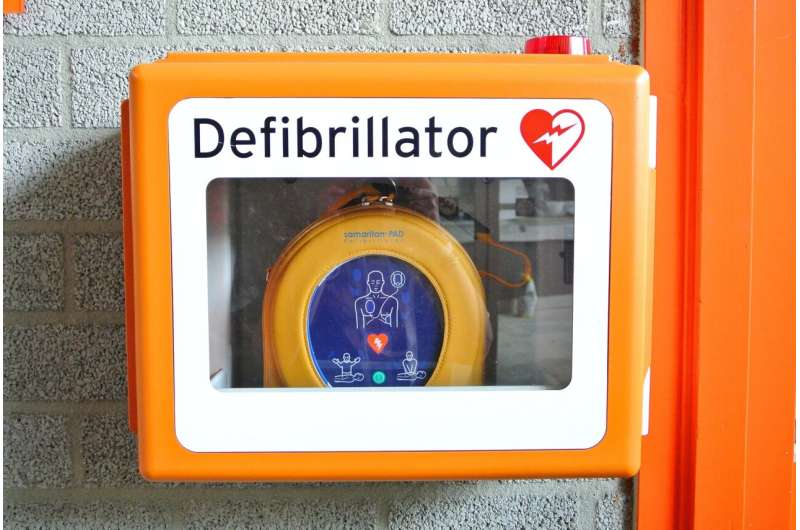This article has been reviewed according to Science X's editorial process and policies. Editors have highlighted the following attributes while ensuring the content's credibility:
fact-checked
trusted source
proofread
Missed opportunity: Automated external defibrillators near cardiac arrests rarely used by bystanders

Automated external defibrillators (AEDs) are a common resource in public buildings, yet a new analysis reveals that they are rarely used to help resuscitate people suffering cardiac arrest. Research presented at the American College of Cardiology's Annual Scientific Session, found that AEDs were only used in 13 of nearly 1,800 cases of out-of-hospital cardiac arrest, even though many of the incidents occurred near a public AED.
Cardiac arrest occurs when the heart suddenly stops beating. It is different from a heart attack, which is when a blockage prevents blood from reaching the heart. Cardiac arrests often happen without warning, causing a person to collapse and become unresponsive. Cardiac arrests outside of a hospital setting are usually fatal but administering cardiopulmonary resuscitation (CPR) and using an AED greatly increases the chances of survival.
AEDs—devices that analyze the heart rhythm and deliver an electric shock if necessary—are designed to be easy for untrained bystanders to use, and many states have laws requiring these devices to be available in public places, such as airports, shopping malls, schools and gyms.
"Public AED availability is critical for people to be able to use them in the appropriate time and fashion," said Mirza S. Khan, MD, a physician and medical informatician at the University of Missouri-Kansas City and the study's lead author. "However, people need to know it's there to be able to use it. It's not sufficient just to have them in the right places."
The study used data from a national registry to analyze 1,799 cardiac arrests that occurred at home or in public settings in Kansas City, Missouri between 2019–2022. Researchers calculated walking times from where each cardiac arrest occurred to the nearest registered AED using a database of public AEDs in the city.
According to the results, a vast majority (about 85%) of the cardiac arrests occurred at home. A bystander (someone other than a paramedic) administered CPR in 42% of these cases but AEDs were never used. Researchers calculated that nearly one-quarter of at-home cardiac arrests occurred within a four-minute walk of a public AED.
Among cardiac arrests that occurred in public, a bystander administered CPR in about 42% of cases and used an AED in about 7% of cases. Nearly half of these cardiac arrests occurred within a four-minute walk of an AED. Even in the "optimal scenario" in which a bystander administered CPR and the event occurred within a four-minute walk of an AED (the "optimal" scenario), an AED was used in only about one out of four cases.
Taken together, the results suggest that AEDs are often available but underutilized. By drawing attention to this gap, the findings could help inform ongoing efforts to improve signage around AEDs, provide apps or mapping tools to help people locate them and increase education and awareness through community volunteer training programs.
"It's been heartening to see the enthusiasm from local governments and organizations, who are really keen to use this work to help build up to that next level of narrowing that gap in terms of the AED usage that we'd like to see," Khan said.
According to the U.S. Centers for Disease Control and Prevention, over 356,000 out-of-hospital cardiac arrests occur in the U.S. each year—an average of more than 1,000 each day. It is estimated that only about 10% of people who suffer an out-of-hospital cardiac arrest survive.
Signs of cardiac arrest include sudden collapse and loss of consciousness, being unresponsive to shouting or shaking, gasping for air or not breathing and lack of a pulse. If you believe someone is having a cardiac arrest, you should call 911 right away, look for an AED and give CPR until medical professionals arrive.
More information: Khan will present the study, "Walking Time to Closest Public Automated External Defibrillator for Out-of-Hospital Cardiac Arrest in a Major City," on Saturday, April 6, 2024.




















